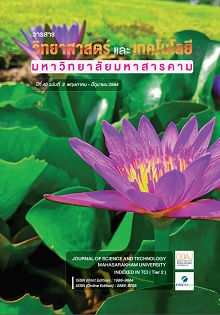การศึกษารูปทรงเครื่องมือกวนเชื่อมที่ส่งผลต่อการเปลี่ยนแปลงโครงสร้างจุลภาคและสมบัติทางกลของการเชื่อมเสียดทานแบบกวนใต้น้ำอลูมิเนียมผสม เกรด 5083
Main Article Content
Abstract
งานวิจัยนี้มีวัตถุประสงค์เพื่อศึกษารูปแบบเครื่องมือกวน 3 แบบ ได้แก่ เครื่องมือกวนแบบรูปทรงกระบอก เครื่องมือกวนแบบรูปสามเหลี่ยมและเครื่องมือกวนแบบรูปทรงสี่เหลี่ยมจากการเชื่อมเสียดทานแบบกวนใต้น้ำของอลูมิเนียมผสม เกรด AA 5083 ที่ส่งผลต่อการเปลี่ยนแปลงของสมบัติทางกลและโครงสร้างทางโลหะวิทยา นอกจากรูปทรงเครื่องมือกวนที่แตกต่างกัน ตัวแปรในการวิจัยนี้ ได้แก่ ความเร็วหมุนเชื่อม 1000, 1400 และ 2000 รอบต่อนาที ความเร็วเดินเชื่อม 80, 112 และ 160 มิลลิเมตรต่อนาที ตามลำดับ ผลการทดลองแสดงให้เห็นว่าเครื่องมือกวนแบบรูปทรงกระบอก ความเร็วหมุนเชื่อม 2000 รอบต่อนาที และความเร็วเดินเชื่อม 112 มิลลิเมตรต่อนาที ให้ค่าความแข็งแรงดึงเฉลี่ยสูงสุดที่ 101.23 MPa ประสิทธิภาพรอยต่อ 37.08 เปอร์เซ็นต์ ในขณะที่เครื่องมือกวนรูปทรงสี่เหลี่ยม ความเร็วหมุนเชื่อม 1400 รอบต่อนาทีและความเร็วเดินเชื่อม 112 มิลลิเมตร มีค่าเฉลี่ยค่าความแข็งแรงดึงต่ำสุด 76.54 MPa สำหรับความแข็งแสดงให้เห็นว่าบริเวณรอยกวนมีค่าความแข็งเฉลี่ย 44 HV100 จากเครื่องมือกวนทรงกระบอก โครงสร้างจุลภาคที่ก่อตัวในรูปของสารประกอบที่ Mg2Si และ Al6(Mn, Fe) ถูกแรงทางกลและความร้อนกระทำส่งผลให้อนุภาคเล็กลงและเปลี่ยนรูปร่างเฟสเป็นสารประกอบ Al3Fe และเฟส Al(Fe)Si นอกจากนั้นแสดงให้เห็นลักษณะการเกิดจุดบกพร่อบริเวณรอยเชื่อม พบว่าเครื่องมือกวนรูปทรงกระบอกเกิดรอยแตกขนาดเล็กด้านล่างรอยเชื่อม ในทำนองเดียวกันเครื่องมือกวนรูปทรงสามเหลี่ยมและสี่เหลี่ยมเกิดรอยแตกด้านล่างรอยเชื่อมเช่นกัน แต่ขนาดโตขึ้นและยังแสดงให้เห็นว่าเครื่องมือกวนรูปทรงสามเหลี่ยมพบช่องว่างบริเวณที่ได้รับอิทธิพลทางความร้อนด้านรีทรีสติ่ง ในขณะที่เครื่องมือกวนรูปทรงสี่เหลี่ยมพบแนวรอยลากกวนที่ไม่ยึดติดกันกลางรอยเชื่อม
This research aimed to study 3 types of tool geometries as follows: a cylindrical, a triangular, and a square shape of underwater friction stir welding with AA 5083 aluminum alloy affecting transformation and mechanical properties. In addition, the different tool geometries and the parameters in this research were: rotation speeds at 1000, 1400, and 2000 rpm and welding speed at 80, 112, and 160 mm/min. The results of this experiment showed that the cylindrical tool with the rotation speed at 2000 rpm and welding speed at 112 mm/min provides the highest average tensile strength at 101.23 MPa, joint efficiency at 62.92 percent. While the square tool with the rotation speed at 1400 rpm and the welding speed at 112 mm/min had an average of the minimum tensile strength at 76.54 MPa. For hardness, the stir zone had an average hardness at 44 HV100 from a cylindrical tool. The microstructures that formed intermetallic compound Mg2Si and Al6(Mn, Fe) phase are transformed by the thermal and mechanical force resulting in smaller particles into transformation to Al3Fe and Al(Fe) Si intermetallic compound. In addition, the defects of the formation with that cylindrical tool was only a small crack at the bottom of the weld. Likewise, triangular and square tools showed cracks below the weld as well, but the size had grown. Besides, with the triangular tool, the voids were found in the retreating side. While, with the square tool, the kissing bond was found in the middle of the weld.


